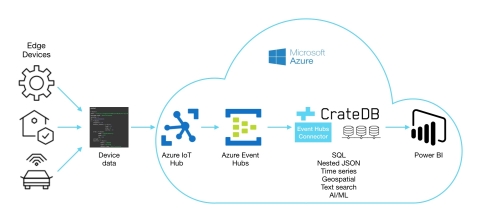SAN FRANCISCO--(BUSINESS WIRE)--Crate.io, developer of CrateDB, a leading SQL data platform for real-time machine data and IoT applications, today announced availability of the CrateDB Event Hubs Connector, a new capability that allows users to route data from Microsoft Azure IoT Hub or Event Hubs directly to CrateDB. This, combined with the database’s rapid ingest and highly-flexible time series queries, gives developers industrial-strength time series database capabilities on Microsoft Azure that are much stronger than other alternatives.
“The success of large-scale Industry 4.0 initiatives depends completely on users’ systems’ abilities to ingest millions of data points from connected equipment and for them to analyze and action that data in real time,” said Holger Mueller, vice-president and principal analyst at Constellation Research. “Traditional SQL databases cannot support time series workloads, legacy time series databases lack the flexibility we need and NoSQL is too risky and complex. The market needs a perfect balance among ease-of-use, rapid ingestion, query flexibility and scale.”
CrateDB lets users of Microsoft IoT Hub put data to work by providing time series monitoring capabilities while enabling data analytics on the extremely large, long-term, complex data sets seen in Industrial IoT. Compared to traditional time series workloads, industrial IoT presents new challenges that CrateDB is uniquely equipped to meet:
- Scale - CrateDB scales out to handle orders of magnitude more time series data or concurrent queries than other time series databases.
- Complexity - Smart factories generate hundreds of different sensor reading structures; many time series databases lack the extensibility to easily support such a variety of time series.
- SQL access - Many time series databases have simple, proprietary interfaces; CrateDB is ANSI SQL, which makes it easier to use, extend, and integrate with other systems.
- OT-IT Integration - The value of Industrial time series data rises significantly when it is integrated and analyzed with data from ERP, CRM, HRIS systems--the OT-IT convergence, which gives more business context and actionability to the time series analyses.
The ability to scale, integrate and extend CrateDB time series data enables users to gain much more insight from machine data and take action quicker to improve operations and profitability. Being able to easily integrate data from other HR, ERP and CRM applications provides context for time series data -- for example, who was on duty during certain factory shifts or which supplier provided raw materials during a specific production run. The juxtaposition of contextual and sensor data accelerates actionability to pinpoint errors, reduce waste, and increase profitability.
NEW Azure Event Hubs and Azure IoT Hub Integration
Microsoft Azure features scalable services for securely streaming machine data from edge devices into the cloud. A new Event Hubs Connector in CrateDB makes it even easier to integrate and analyze IoT data in real time in order to monitor, predict, or control the behavior of smart systems.
The Connector can scale to accept millions of telemetry data readings per second from Event Hubs or IoT Hub and insert it into the CrateDB SQL DBMS. Dynamic Schema Support enables messages of any structure to be inserted into CrateDB, which updates the schema on-the-fly making it easy to integrate new types of connected devices.
Use One Database, not Three
The flexibility of CrateDB -- with its ability to process time series, geospatial, search and nested JSON with SQL -- simplifies smart systems design by eliminating the need to use a variety of specialized databases together. Industrial IoT stacks often feature multiple, specialized databases -- for example, Azure SQL for relational data, Azure Cosmos DB for JSON and InfluxDB or Azure Time Series Insights for time series. CrateDB, with its unique distributed SQL-on-NoSQL architecture, enables it to do the work of all three of those databases. As a result, database hosting and database administration costs are much lower for CrateDB users.
“Most time series databases were developed to support IT systems monitoring, which is a small time series problem. Smart factory, smart city and smart vehicle time series requirements are much more rigorous,” said Christian Lutz, CEO of Crate.io. “The innovations we are announcing today, including the Event Hub Connector, build on the multiple advantages in CrateDB, which already provides the most powerful time series capabilities for putting IoT and machine data to work, at scale.”
About Crate.io
Crate.io develops data management solutions that help companies put IoT and machine data to work. CrateDB is an open source distributed database offering the scalability and performance of NoSQL with the power and ease of standard SQL. The Crate.io Machine Data Platform is a turnkey data layer, offered as a hosted cloud service, enabling faster development of IoT platforms and data-driven smart factories. Crate.io is headquartered in San Francisco with offices in Berlin, New York City, and Dornbirn, Austria.

